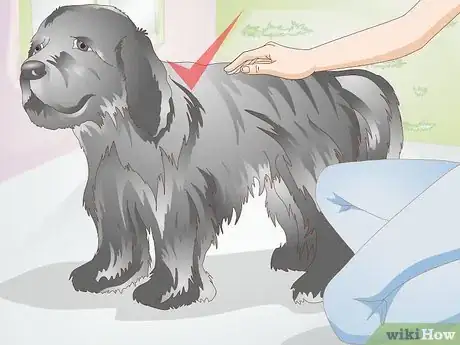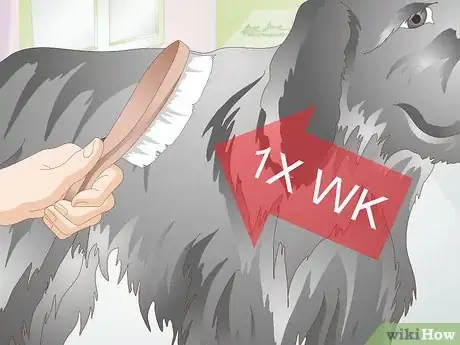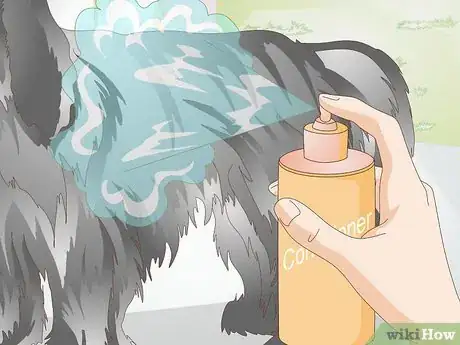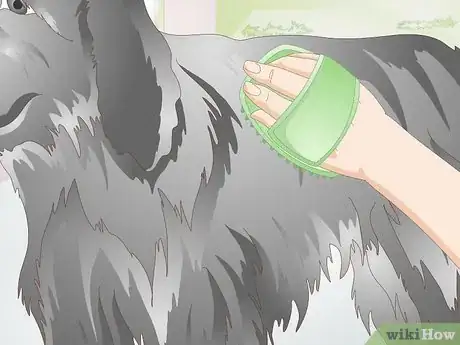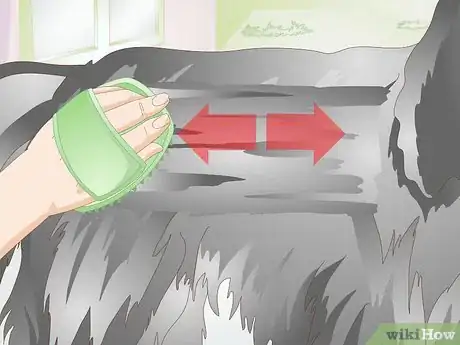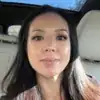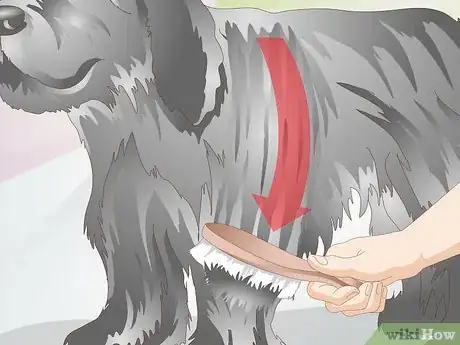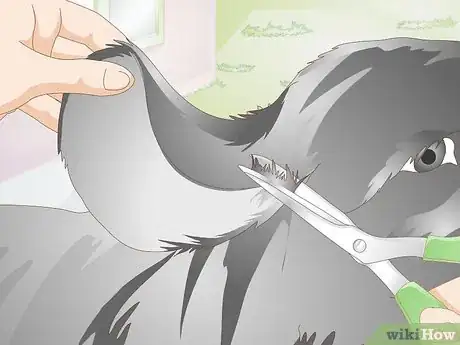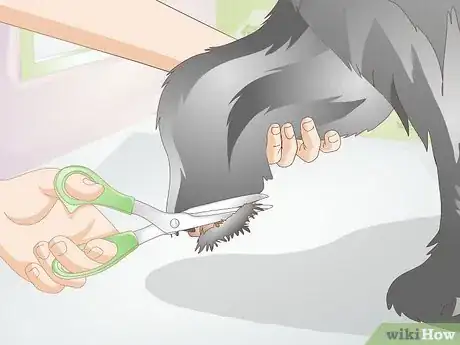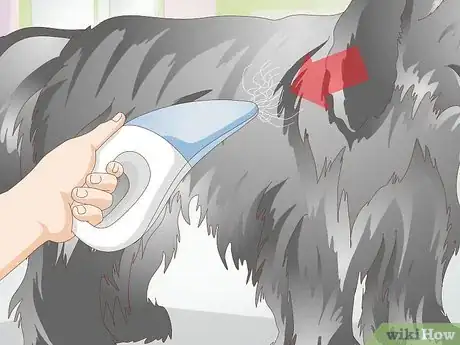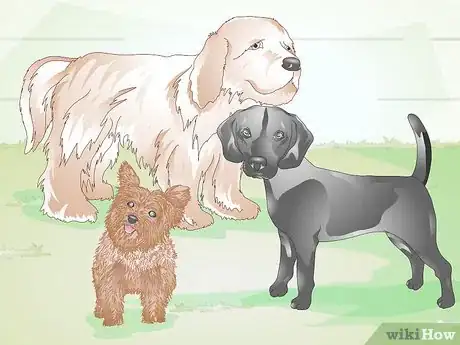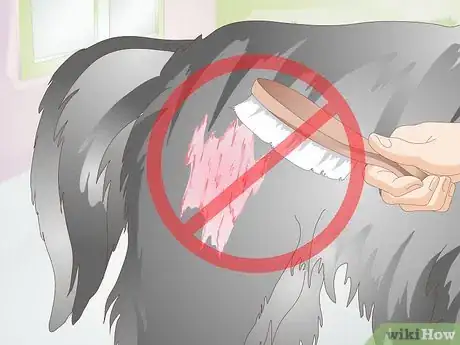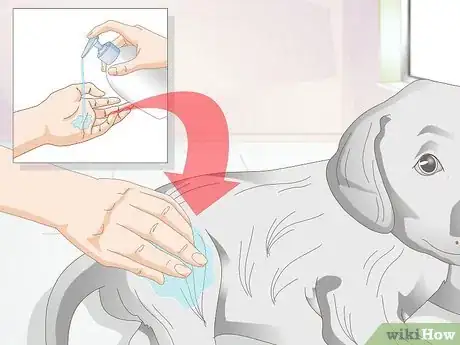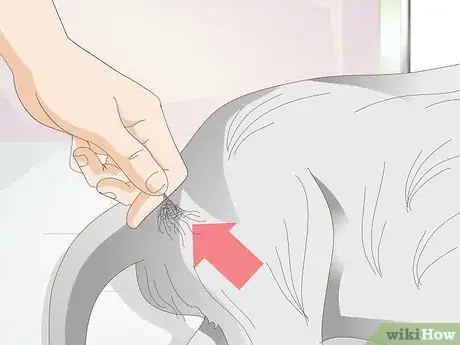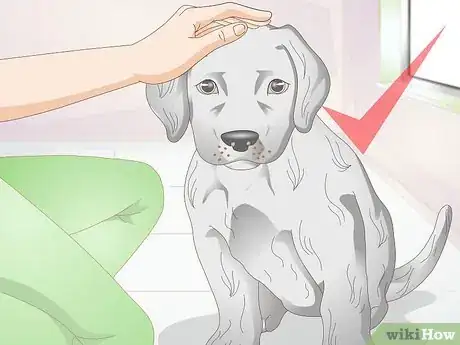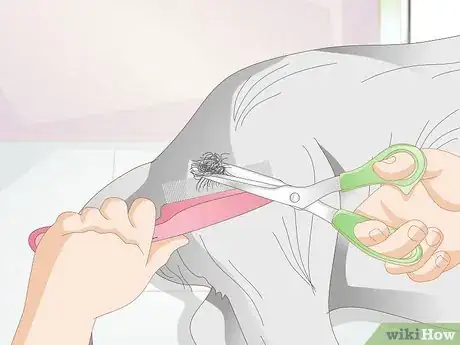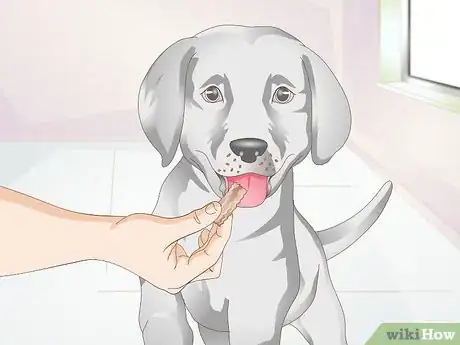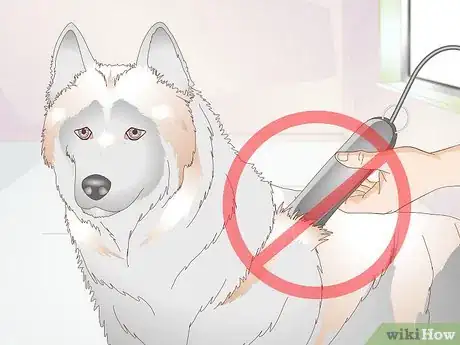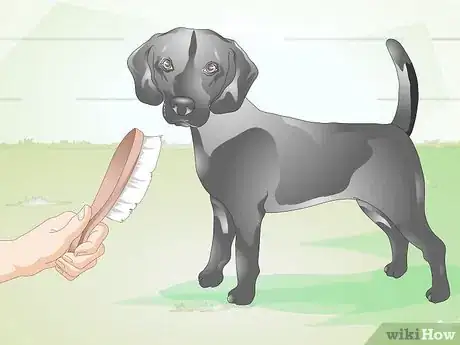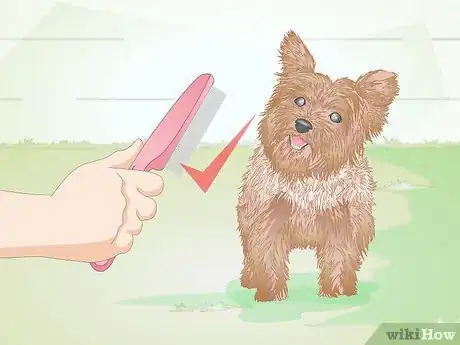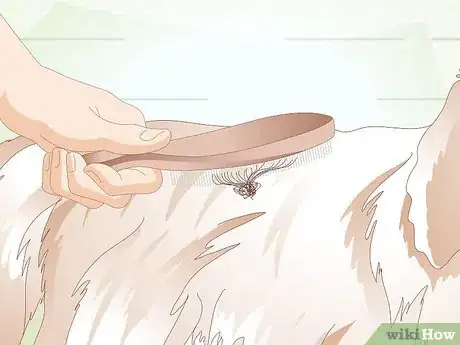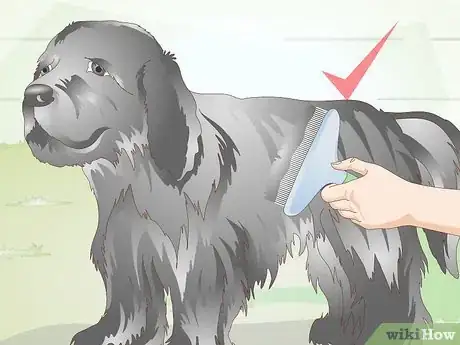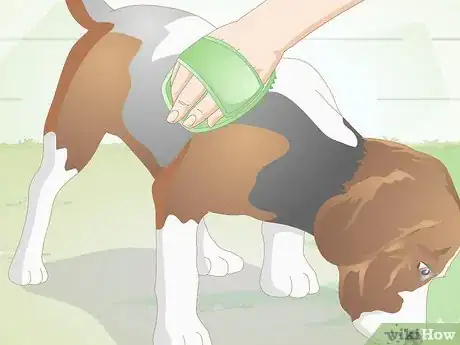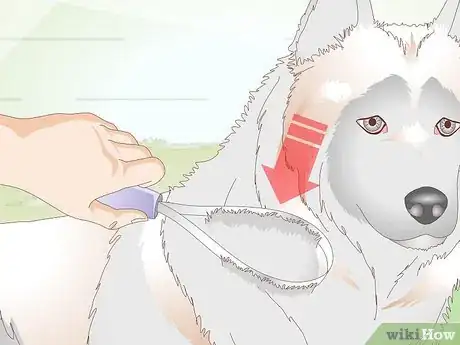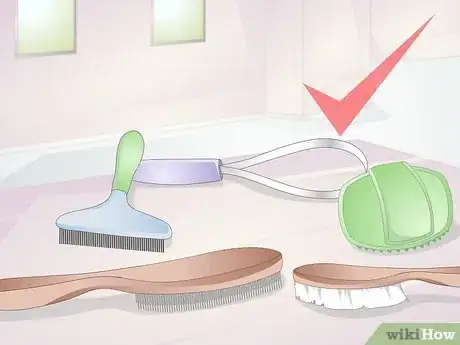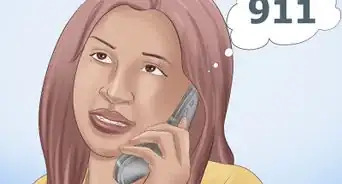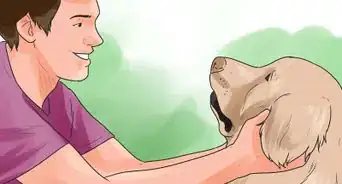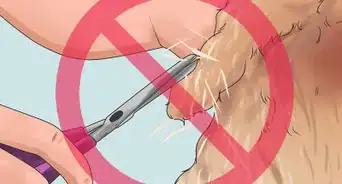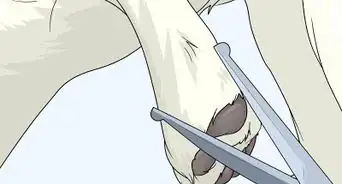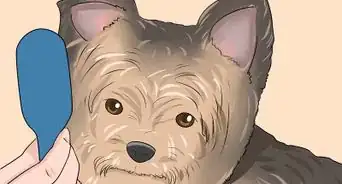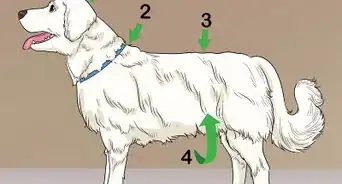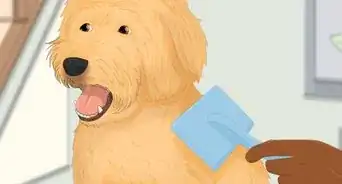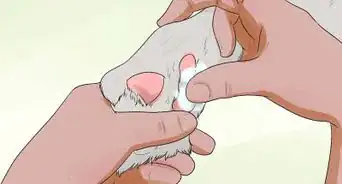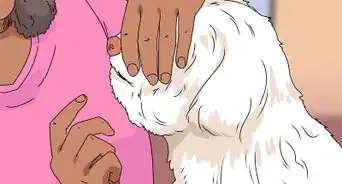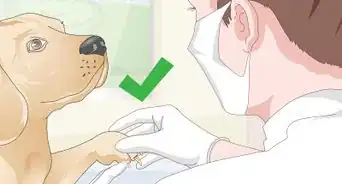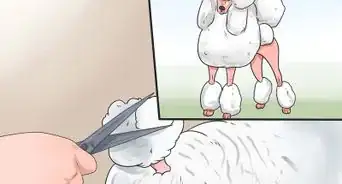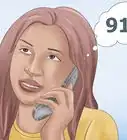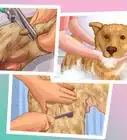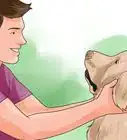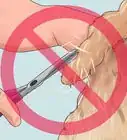This article was co-authored by Marie Lin. Marie Lin is a Licensed Pet Groomer and the Owner of Marie's Pet Grooming, a grooming salon based in New York City. Marie has over 10 years of pet grooming experience specializing in dogs and cats. She earned her pet grooming certification from the American Academy of Pet Grooming New York in 2009 and is also a member of the National Dog Groomers Association of America. She earned a Master of Business Administration (MBA) from Hawaii Pacific University in 2007.
There are 12 references cited in this article, which can be found at the bottom of the page.
This article has been viewed 48,512 times.
Even if you take your dog to a professional groomer for baths and haircuts, you still need to take care of his coat in between visits. Brushing removes dead hair and removes matted clumps of hair and debris. It also distributes the natural oils in your pet's coat and stimulates blood circulation near the surface of the skin. Regular brushing gives you an opportunity to check your dog for anything out of the ordinary and take care of it, like removing wood ticks or tending to minor cuts. It's also a great way to bond with your dog.
Steps
Brushing with Good Technique
-
1Prepare your dog. Find a safe, quiet place to brush your dog. If the weather is nice, outdoors is a good bet because you won't have to worry as much about cleaning up the dead hair. Make sure your dog feels comfortable with you, and speak in a calm, reassuring voice throughout the grooming session.
- Ask your dog to sit, and then give them a treat. Always try to start your grooming ritual on a good note.
- Let your dog sniff the brushes and tools you are using, before you begin.
-
2Be systematic about brushing. Try to follow a regular schedule, and brush short and medium haired pets about once a week. Long haired dogs usually need to be brushed daily. For all brushing steps, begin at your dog's head and work toward his tail. Brushing the same way every time will help keep you from skipping a step, and will also be reassuring for your dog.[1]
- Some professional groomers say that starting with the tail and working forward helps keep very nervous dogs calm, because they can't see what is happening at first.
- If you plan to bathe your dog, brush her first. Tangles become tighter and harder to remove when they are wet.
Advertisement -
3Spray on some coat conditioner. If your pet has very tangled hair, or if he has long hair that is prone to mats, spray on a commercial pet coat product such as mink oil before brushing. This will help loosen knots and tangles.[2]
-
4Use a rubber brush or curry comb to loosen dead skin and dirt. Rubber curry combs are great to use on the paws, ears, and tail, as long as you work gently. Using the rubber comb in a gentle, circular motion all over your dog will help distribute oils and keep her coat soft and shiny.[3]
- Never use a metal curry comb on your dog – these are used to clean fur out of other brushes. Metal curry combs are too harsh to use on your pet's delicate skin.
-
5Use firm, but gentle strokes. On thick coats, brush against the grain starting at the skin and brushing outward. Then start over, brushing in the same direction as hair growth. For all other coats, brush in the same direction the hair grows.
- Brush the hair close to your pet's skin, but do not brush the skin itself. This can cause red, irritated skin called “brush burn,” which may need to be treated by your vet.
- Use long strokes for long-haired dogs.
- Use short strokes for dogs with short or wiry hair.
- If you're using a soft-bristled brush, brush lightly but quickly, following the direction of the fur.[4]
-
6Brush in the same order every time. Brush your dog's neck ruff and any feathering on her legs. If your dog has longer hair around his neck on on his legs, you may want to use a comb to detangle any knots before brushing. Then gently brush his underbelly, sides, back, rear end, hind legs, and tail.
- Be very careful when brushing your pet's delicate underbelly. Never brush directly on the skin.
- Also be very careful when brushing his face – for most dogs, facial hair can be groomed with a damp cloth. Longer hair can be gently groomed with a comb.
-
7Groom your dog's ears. Cleaning your dog's ears weekly will be make him feel more comfortable, and will help avoid ear infections. If your dog has long hair on his ears, trim it gently with scissors. Check the area thoroughly for ear mites, ticks, and fleas. Then use a cotton ball or piece of surgical gauze soaked in an ear cleaning solution, or a baby wipe wrapped around your finger and gently wipe the inside surface of your dog’s ears.[5]
- Avoid using water in your dog's ears – it doesn’t evaporate very easily and can lead to ear infections.
- Never use Q-tips or try to put anything in your dog's ear canal – this can easily cause a painful ear injury.
- If you notice an unusual smell or a discharge coming from your dog’s ears, bring it to your veterinarian’s attention.
-
8Take care of your pet's feet. Keeping the hair on your dog's feet neat and tidy not only looks good, it reduces the number of things that will get caught there, like burrs, road tar, ice chunks, bugs, and road tar. Trim the hair on the top of your dog's foot carefully with scissors, along with the hair on the bottom of his paw so that the hair is about even with the pads of his foot. Do not try to trim the hair between the toes or pads of the feet – you could injure your dog if he moves suddenly.[6]
-
9Remove any remaining loose, dead hair. Follow with a comb on long haired dogs to remove loose hair. You can also use a small, hand-held vacuum if you are careful and your dog isn't afraid of the noise. If your dog has a smooth, short coat like a Chihuahua or Boxer, use a chamois cloth to polish her coat.[7]
-
10Tailor your grooming routine to your dog's specific breed. Various breeds of dogs have different types of coats, and they each have their own grooming requirements. How frequently you need to groom, are based on three main factors: whether his coat is short or long (over one inch), whether he has a single or double coat, and whether he has feathering (longer fringe on the neck, ears, legs, and tail.)[8]
- Breeds with long, silky, single coats – such as Maltese and Yorkshire Terriers – are highly prone to tangles. Comb these dogs daily, or at a minimum once every two days.
- Breeds with feathering – such as Cocker Spaniels, Shih Tzus, Lhasa Apsos, Irish Setters, and Golden Retrievers – will require frequent combing along with brushing.
- Double coated dogs – such as Pomeranians, Shetland Sheepdogs, Siberian Huskies, and Samoyeds – shed more than other dogs, and their undercoat needs to be brushed thoroughly during shedding seasons.
- Many short haired breeds – such as Chihuahuas, Labrador Retrievers, and Greyhounds – can go as long as two weeks between brushing.
-
11Avoid over-grooming. Try to stick to a regular routine when brushing or bathing, and always work gently. It's difficult to hurt your dog by brushing him too often, but brushing too hard or with the wrong type of brush – for example, a slicker brush on a short-haired breed – can cause painful skin irritation.[9]
- Bathing too often can strip the natural oils from your pet's skin, causing dry, itchy patches.
- Bathing without the proper coat conditioning can dry his coat, making it brittle and dry.
Removing Mats and Tangles
-
1Apply coat conditioner directly to the mat. Use a generous amount of a commercial conditioner and massage it into the affected area. If a small mat isn't treated immediately, it can turn into a serious and painful problem. Coat conditioner helps to loosen the tangles so you can remove them more easily.[10]
-
2Untangle the mat slowly. Mats can be very hard, packed with dirt and hair, and can become jammed against your dog's skin. Even very small mats made of five or ten hairs can pull the skin under the dog’s arms and can cause infections from the transfer of bacteria around genital areas. Parasites like ticks and fleas also like to hide in mats, so you should always take care of them as soon as possible.[11]
- Try to untangle the mat manually with your fingers before you begin with the comb.
- Use the wide teeth of the comb first, holding the mat firmly in your fingers so you don't pull your dog's hair when you pull at the mat.
- Use the finer teeth of the comb once you have broken up most of the mat.
-
3Be patient with your dog, and give him breaks if necessary. This is a difficult process for your dog, as well, and if he moves or jerks while you are grooming him you might accidentally hurt him. If you are rough or impatient while grooming your dog, it can erode the trust between you.[12]
- Remember that most dogs will try to chew out a hair tangle when it starts to bother them, so the area may already be quite sensitive before you begin.
-
4Use scissors sparingly. If you can't remove the tangle you may be able to cut it out with scissors. Put the comb in your dog's hair between the tangle and his skin, then cut the mat out with scissors. This will help you avoid cutting your dog.
-
5Reward your dog. When you finish your grooming session, always reward your dog with a nice to treat to thank them for being patient. This will encourage them to look forward to the next grooming session.
-
6Avoid shaving your double coated dog. With proper grooming, shaving any breed of dog is rarely necessary, and should only be done on the advice of your vet or a trusted professional groomer. You should never shave your dog if you have one of the double-coated breeds, like Pomeranians, Shetland Sheepdogs, Siberian Huskies, Samoyeds. The outer coat on a double coated dog protects them from extreme heat and cold, UV rays, and bug bites.
- Groom your dog's undercoat more thoroughly in the Spring and other shedding periods. If the undercoat becomes matted, air can't circulate between the outer coat and the skin and your dog loses his ability to stay cool in warm weather.
- Shaving the undercoat will not prevent shedding.
- Some dogs, especially older dogs, will not regrow their top coat after being shaved. They will be left with a patchy, scruffy undercoat and no protective outer coat – permanently.
Choosing the Right Brush
-
1Use a bristle brush for almost any type of coat. For breeds with longer hair, choose a brush with longer bristles in more widely spaced rows. For shorter coats, choose a brush with shorter bristles that are closer together. For softer hair, use a soft-bristled brush. For very coarse hair, choose a brush with very stiff bristles.[13]
-
2Use a wire-pin brush for long or curly coats. Wire-pin brushes are made with or without rubber tips on the wire bristles. Try this type of brush if your dog has an especially wooly or curly coat, or if he has medium to long hair of any type.[14]
-
3Try a slicker brush to remove tangles. A slicker brush has very fine wire bristles and is very good at removing mats, burrs, and tangles. A wood-handled comb is also used for this purpose - try to find one with a set of wide teeth and a set of finer teeth.[15]
-
4Try an undercoat rake on very thick fur. If your dog has very thick fur with an insulating undercoat, such as an Akita, this rake will help groom this thick hair. An undercoat rake is very versatile and can also be used on other dogs, or even long-haired cats.
-
5Use a rubber curry comb. Similar to the curry combs used to groom horses, these are great for short haired breeds such as Dobermans and Beagles.
-
6Use shedding blades with caution. Shedding blades are designed to remove loose, dead hair. Used improperly, they will remove chunks of healthy hair and may even slice your dog's skin.
-
7Use the correct brushes for your dog's breed. Choose brushes that complement your dog's particular coat type. Dog brushes are designed to perform specific functions on certain types of hair. Using the wrong type of brush for your dog's coat may irritate the skin.[16]
- Smooth coat (Bull Terrier, Dachsund, Chihuahua) – Use a bristle brush once every one to two weeks, and brush against the grain to loosen and remove dead hair.
- Double coat (Rottweiler, Chow, Husky and Collie) – For long or short double coats, brush weekly throughout the year and more frequently during shedding seasons. Use a slicker brush to groom the undercoat, then go over the outer coat with the same brush. Use a wide-tooth comb to groom the longer layers and remove tangles.
- Wire coat, or Broken Coat (Airedales, Irish Wolfhound) Use a stripping comb lightly over your dog's back, gently pulling out the hairs to thin the overgrown, wiry coat – wire coats are not attached to the skin like other hair types, so this does not hurt your dog when done gently. Then brush the coat in layers from the skin outward with a slicker brush.
- Curly coat (Poodle, Bichon Frise) - Use a slicker brush against the grain to fluff it up, then bathe and blow dry while brushing with the slicker brush with the grain.
- Long coat (Shih Tzu, Lhasa Apso, Yorkshire Terrier, Maltese) – Use a slicker brush on the coat in the direction of the hair, then go over the entire coat with a soft bristle brush.
- Flocking coat or Cording coat (Bergamasco Shepherd, Komondor or Hungarian sheepdog) – These dog's coats are made of hair, not fur, which gradually clumps together to form natural “dreadlocks.” Although they have long hair, breeds with flocking coats are considered to be non-shedding. They also do not need to be brushed.[17]
- Hairless coat (Mexican Hairless, Inca Orchid, Chinese Crested) – Hairless breeds don't need to be brushed at all, but they do need to be bathed on a regular basis.
Community Q&A
-
QuestionWhat type of brush or comb should I use on my 4-year-old Chiweenie?
 Community AnswerYou should use a soft bristle brush or a short metal bristle brush to remove shedding fur.
Community AnswerYou should use a soft bristle brush or a short metal bristle brush to remove shedding fur.
References
- ↑ http://www.aspca.org/pet-care/dog-care/dog-grooming-tips
- ↑ http://www.aspca.org/pet-care/dog-care/dog-grooming-tips
- ↑ http://herepup.com/what-is-the-best-dog-brush-for-a-shedding-dog/
- ↑ Marie Lin. Licensed Pet Groomer. Expert Interview. 31 March 2020.
- ↑ https://www.animalhumanesociety.org/training/grooming-tips-dogs
- ↑ https://www.animalhumanesociety.org/training/grooming-tips-dogs
- ↑ http://www.peteducation.com/article.cfm?c=2+2095&aid=785
- ↑ http://www.vetstreet.com/our-pet-experts/am-i-a-bad-pet-owner-if-i-dont-brush-my-long-haired-dogs-coat?page=2
- ↑ http://pets.thenest.com/can-over-brush-dog-12200.html
- ↑ https://www.teddybeargoldendoodles.com/blog/grooming/help-my-doodle-has-mats
- ↑ https://www.cairnrescue.com/resources/removing-hair-mats/
- ↑ https://www.cairnrescue.com/resources/removing-hair-mats/
- ↑ http://www.peteducation.com/article.cfm?c=2+1643&aid=789
- ↑ http://www.peteducation.com/article.cfm?c=2+1643&aid=789
- ↑ http://www.peteducation.com/article.cfm?c=2+1643&aid=789
- ↑ http://cowboymagic.com/6-dog-coat-types-and-how-to-groom-them/
- ↑ http://www.dogbreedinfo.com/b/bergamascogrooming.htm
About This Article
To brush your dog, start by using a rubber brush or curry comb in a circular motion all over your dog to loosen dead skin and dirt. Then, brush it from head to tail with a bristle brush, using firm but gentle strokes. If you have a long-haired dog, brush it every day. Alternatively, brush your short- or medium-haired dog once a week. Additionally, brush your dog the same way each time so you remember to cover every part of its body. For more tips from our Veterinary co-author, like how to remove mats and tangles from your dog’s coat, read on!
